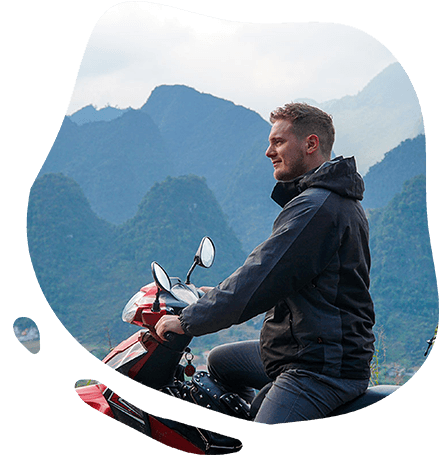Was ist der Ha Giang Loop?
Der Ha Giang Loop ist eine berühmte Route im äußersten Norden Vietnams, bekannt für seine unglaublichen Berge und reiche Kultur. Mit dem Motorrad, auf einer Easy-Rider-Tour oder im Auto entlang dieser Schleife zu fahren, lässt dich atemberaubende Ausblicke genießen und die Lebensweise der einheimischen ethnischen Gruppen erleben, die hier seit Jahrhunderten leben. Diese Reise beginnt und endet in Ha Giang City und umfasst mehrere hundert Kilometer. Die meisten Leute brauchen 3 bis 5 Tage, um sie zu absolvieren, und passieren dabei beeindruckende Landschaften, Bergpässe, Stammesmärkte und traditionelle Dörfer. Es ist ein Abenteuer, das dir das Beste von Ha Giang’s natürlicher Schönheit und kultureller Vielfalt zeigt.
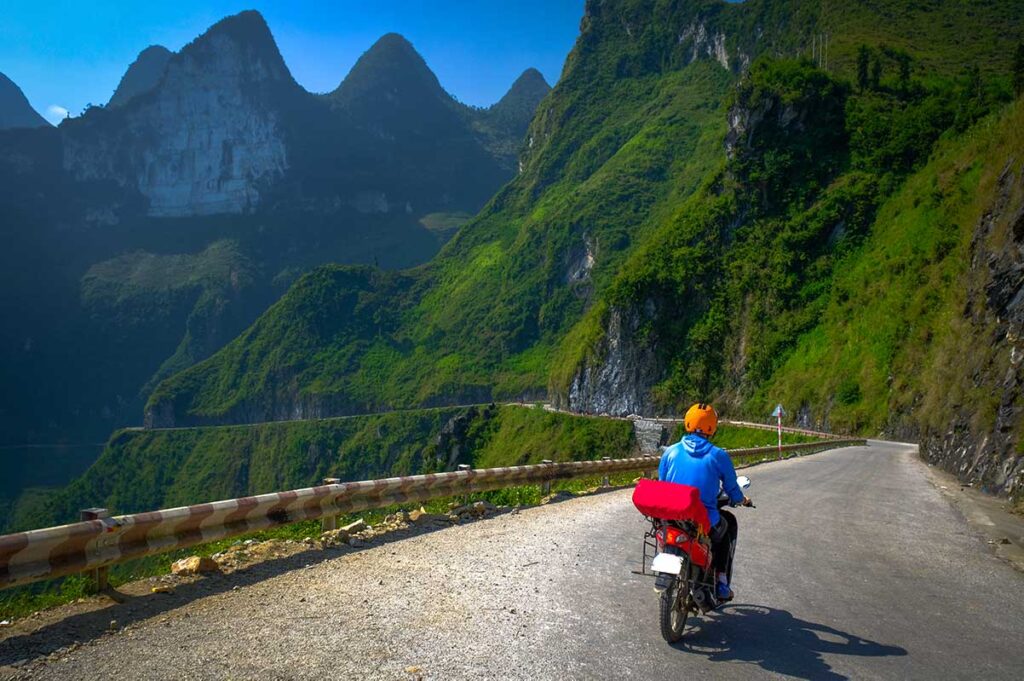
Wie kommt man nach Ha Giang?
Entfernung und Reisezeit
Der Ha Giang Loop beginnt und endet in Ha Giang City, der Provinzhauptstadt, die denselben Namen wie die Provinz trägt. Obwohl du auch von Hanoi aus starten kannst, ziehen es die meisten Reisenden vor, einen Bus von Hanoi nach Ha Giang zu nehmen, da diese Route hauptsächlich die Autobahn nutzt und schneller, wenn auch weniger landschaftlich reizvoll ist. Derzeit dauert die Fahrt etwa 6 Stunden, aber dies soll sich auf 3 Stunden verkürzen, sobald eine neue Schnellstraße fertiggestellt ist.
Option 1: Limousinen Bus
Limousinenbusse, im Grunde luxuriöse Kleinbusse mit 12 bis 20 Sitzplätzen, fahren tagsüber. Sie bieten eine komfortable Fahrt für etwa 300.000 VND (12 EUR) und benötigen ungefähr 6,5 Stunden von Hanoi nach Ha Giang. Wenn du am frühen Nachmittag ankommst, kannst du entweder sofort mit der Schleife beginnen oder Ha Giang erkunden und über Nacht bleiben, bevor du am nächsten Tag startest.

Option 2: Schlafbus
Schlafbusse sind ideal für diejenigen, die ihre Zeit maximieren möchten, indem sie über Nacht reisen und so Tageslichtstunden für die Erkundung sparen. Auch wenn nicht jeder gut in diesen Bussen schlafen kann und einige Nachtfahrten beängstigend finden, ermöglicht dir diese Option, die Ha Giang Loop gleich am Morgen zu beginnen.

Die Busse fahren normalerweise gegen 20:00 oder 21:00 Uhr in Hanoi ab und kommen gegen 3:00 Uhr in Ha Giang an. Einige Unternehmen lassen dich bis zum Morgen im Bus bleiben, aber für eine gute Ruhe kannst du auch ein Hotel oder Hostel buchen.
Option 3: VIP-Schlafbus
Der VIP-Schlafbus bietet eine komfortablere Version des Standard-Schlafbusses für eine etwas höhere Gebühr. Mit mehr Platz, Vorhängen und manchmal sogar einer Massagefunktion in den Sitzen bietet er ein erstklassiges Reiseerlebnis über Nacht, sodass du die Schleife ausgeruht beginnen kannst.

Option 4: Privates Auto
Obwohl Limousinen-Vans zwischen Ha Giang und Hanoi mehr Komfort zu geringeren Kosten bieten, bietet die Wahl eines privaten Autos unvergleichliche Flexibilität hinsichtlich der Reisezeiten und spezifischer Abhol- und Abgabeorte. Diese Option eignet sich für diejenigen, die Komfort und personalisierte Reisepläne priorisieren.
Wie man sich fortbewegt: Motorrad oder Auto
Um den Loop zu erkunden, hast du drei Hauptoptionen:
Option 1: Motorradfahren
Der Ha Giang Loop ist gleichbedeutend mit Motorradabenteuern und bietet ein unvergleichliches Gefühl von Freiheit und Verbundenheit mit Vietnams beeindruckendsten Berglandschaften. Ein Motorrad in Ha Giang zu mieten, dem Ausgangspunkt der Schleife, ist unkompliziert, da es zahlreiche Mietgeschäfte gibt.
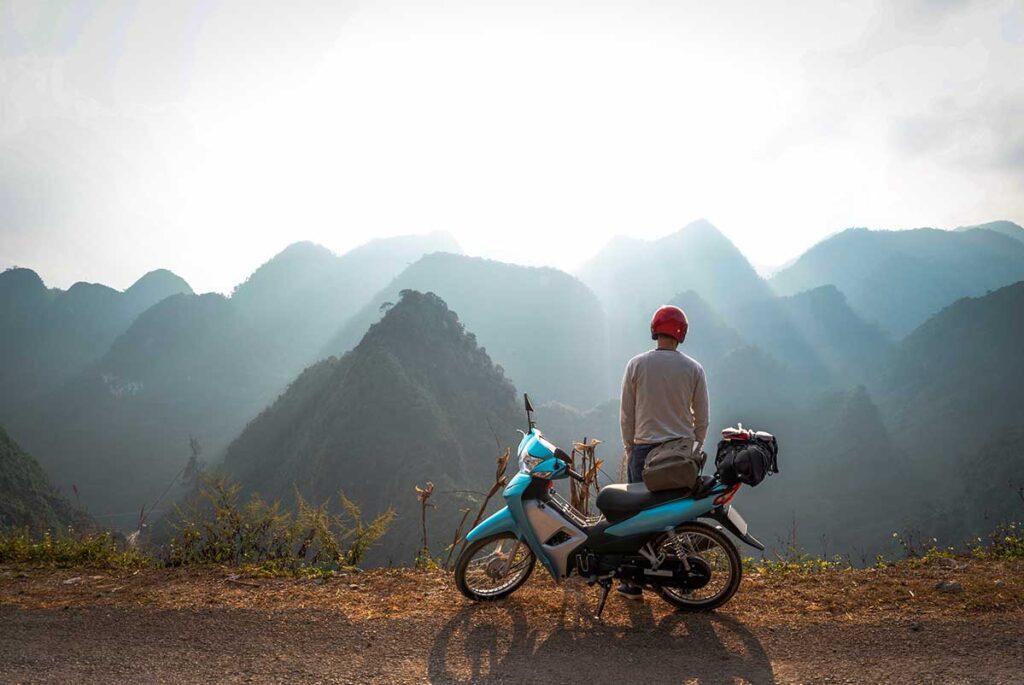
Es ist jedoch wichtig, deine Fahrpraxis zu berücksichtigen und sicherzustellen, dass du einen gültigen Motorradführerschein hast, da das Navigieren auf den Bergstraßen ohne vorherige Erfahrung gefährlich sein kann.
Option 2: Easy-Rider-Tour
Für diejenigen, die von der Motorraderfahrung fasziniert sind, aber keine Fahrkenntnisse haben, ist die Easy-Rider-Tour eine ausgezeichnete Alternative. Diese Touren verbinden dich mit lokalen Führern, die nicht nur erfahrene Motorradfahrer sind, sondern auch umfangreiches Wissen über die Region besitzen.
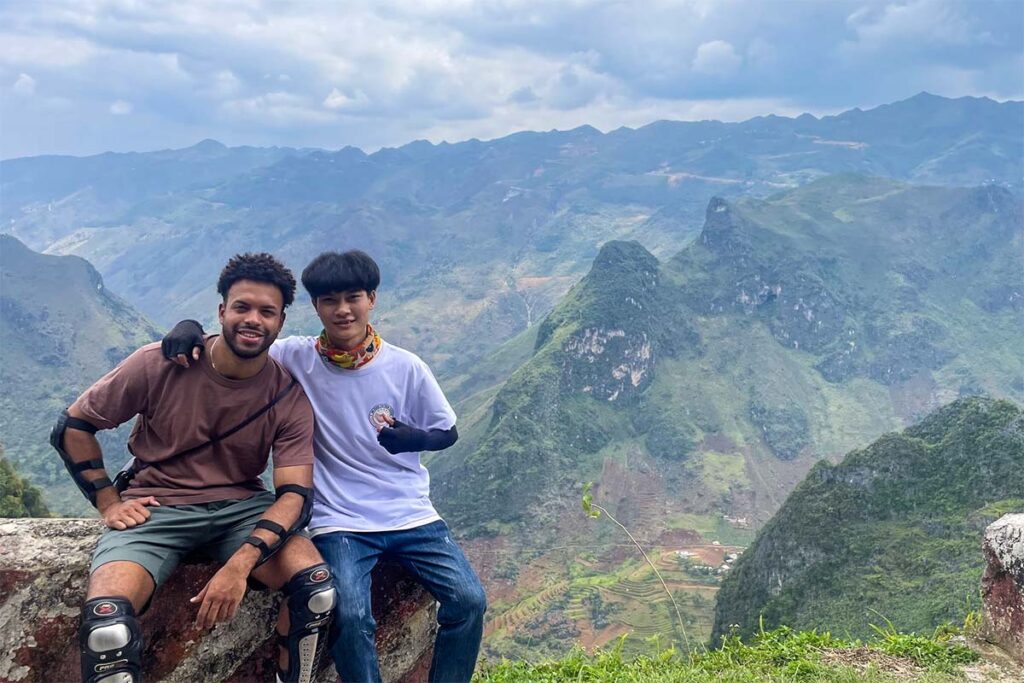
Eine Easy-Rider-Tour bedeutet sichereres Reisen, bereichernde lokale Einblicke und die Freiheit, die Reise zu genießen, ohne sich um die Navigation zu kümmern. Diese Option ist für alle Altersgruppen geeignet und bietet eine abenteuerliche, aber sichere Möglichkeit, Ha Giang’s majestätische Landschaften zu erkunden.
Option 3: Autotour
Für Besucher, die es vorziehen, nicht mit dem Motorrad zu reisen, ist eine Tour mit dem Auto eine praktikable und bequeme Alternative. Obwohl das Abenteuergefühl anders ist als bei der Motorraderfahrung, bietet das Reisen mit dem Auto mehrere Vorteile, einschließlich der Möglichkeit, mehr Gepäck mitzunehmen, bequemer zu sitzen und besser vor den Elementen geschützt zu sein, sei es Regen, Wind oder extreme Temperaturen im Sommer und Winter. Diese Option folgt der gleichen Route wie das Motorrad, sodass du keine der Highlights des Loops verpasst, während du erhöhten Komfort und Bequemlichkeit genießt.
Unterkunft entlang des Loops
Traditionelle Homestays
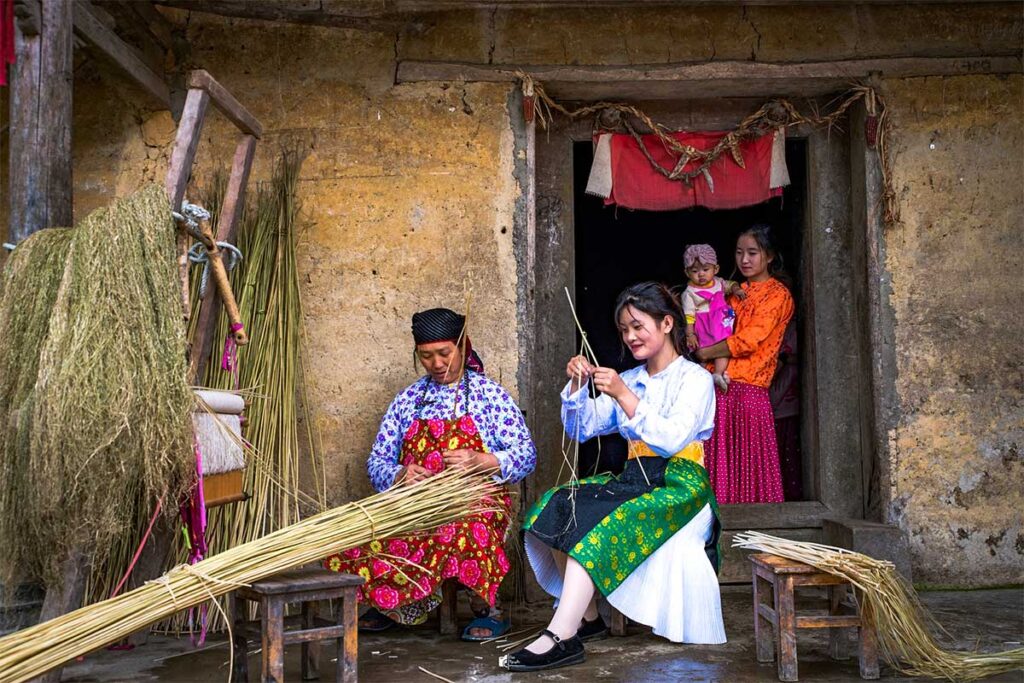
Bei einer einheimischen Familie in einem traditionellen Homestay zu übernachten, ist eine unschätzbare Gelegenheit, die Kultur der ethnischen Minderheiten Ha Giangs zu erleben. Diese Unterkünfte sind meist einfach, bieten aber ein reiches kulturelles Erlebnis, einschließlich gemeinsamer Familienessen und Einblicke in das traditionelle Leben. Es ist jedoch wichtig zu beachten, dass nicht alle Homestays dieses Maß an Authentizität bieten; einige ähneln eher kleinen Hotels als echten Familienhäusern.
Backpacker (Party) Homestays
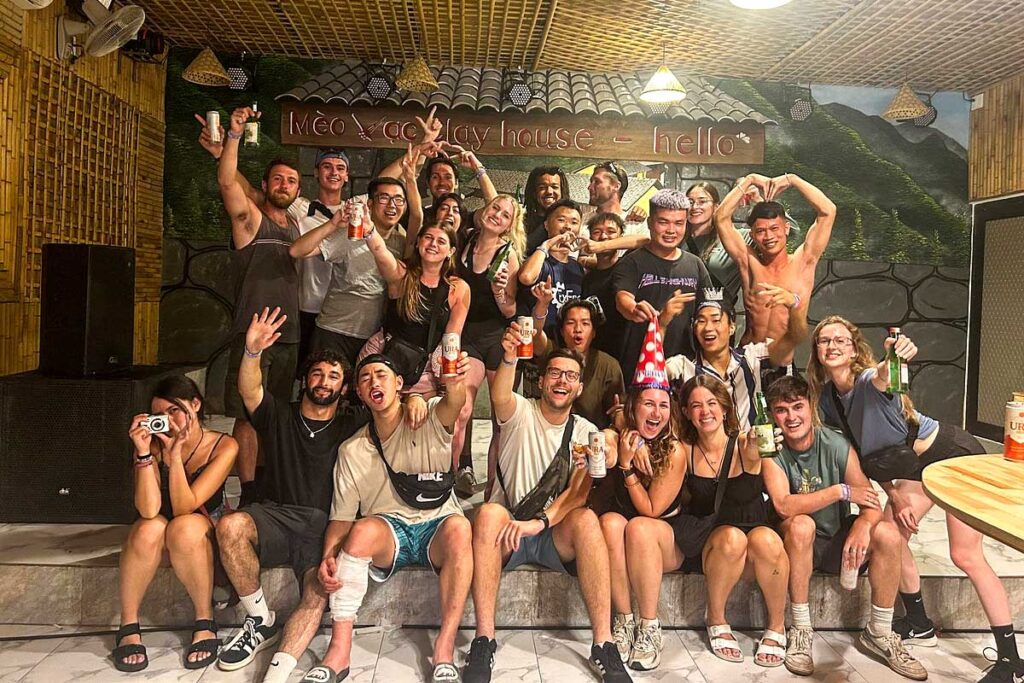
Die Beliebtheit Ha Giangs bei Rucksacktouristen hat zur Entstehung von partyorientierten Homestays geführt. Diese Orte sind oft auf größere Gruppen ausgerichtet und bieten Karaoke- und Trinkaktivitäten, was sie zu einer spaßigen Wahl für Alleinreisende macht, die andere treffen möchten. Wenn du jedoch eine ruhigere Erfahrung suchst, solltest du recherchieren und eine Unterkunft wählen, die deinen Vorlieben entspricht.
Hotels
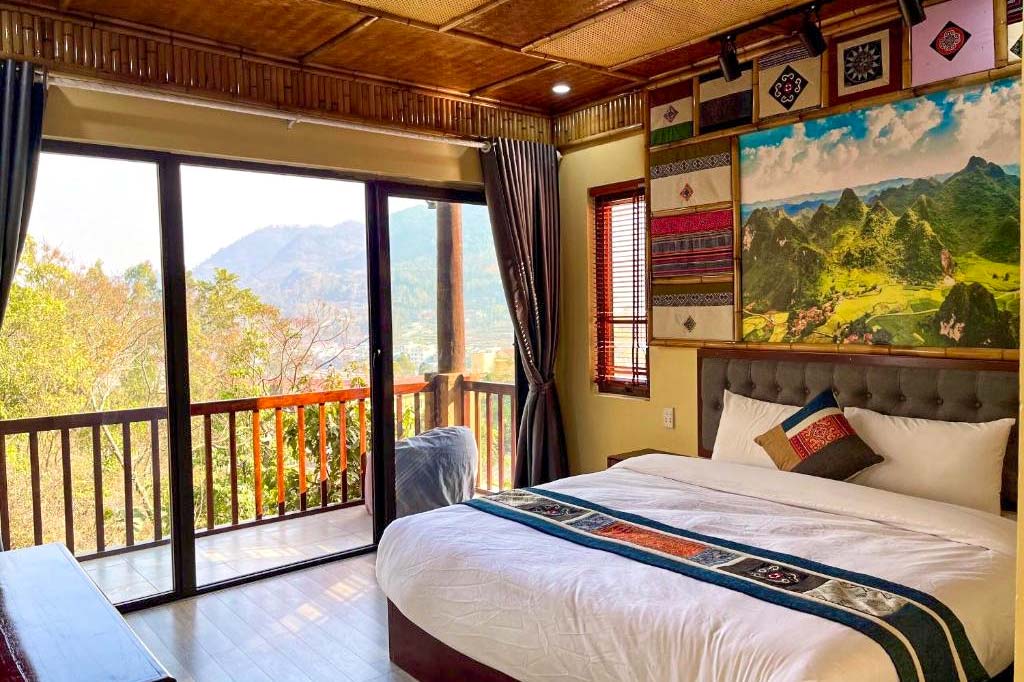
Hotels in Ha Giang befinden sich hauptsächlich in größeren Städten wie Dong Van und Meo Vac. Sie bieten in der Regel mehr Privatsphäre und Komfort, einschließlich Annehmlichkeiten wie Klimaanlage, die an heißen Tagen eine Erleichterung und im Winter Wärme bieten können. Während Hotels möglicherweise nicht die authentische und gemütliche Atmosphäre von Homestays haben, sind sie eine gute Option für diejenigen, die Komfort priorisieren. Beachte jedoch, dass der Standard der Hotels in Ha Giang möglicherweise nicht mit dem in entwickelteren Touristengebieten übereinstimmt, obwohl die Qualität allmählich besser wird.
Lodges & Resorts
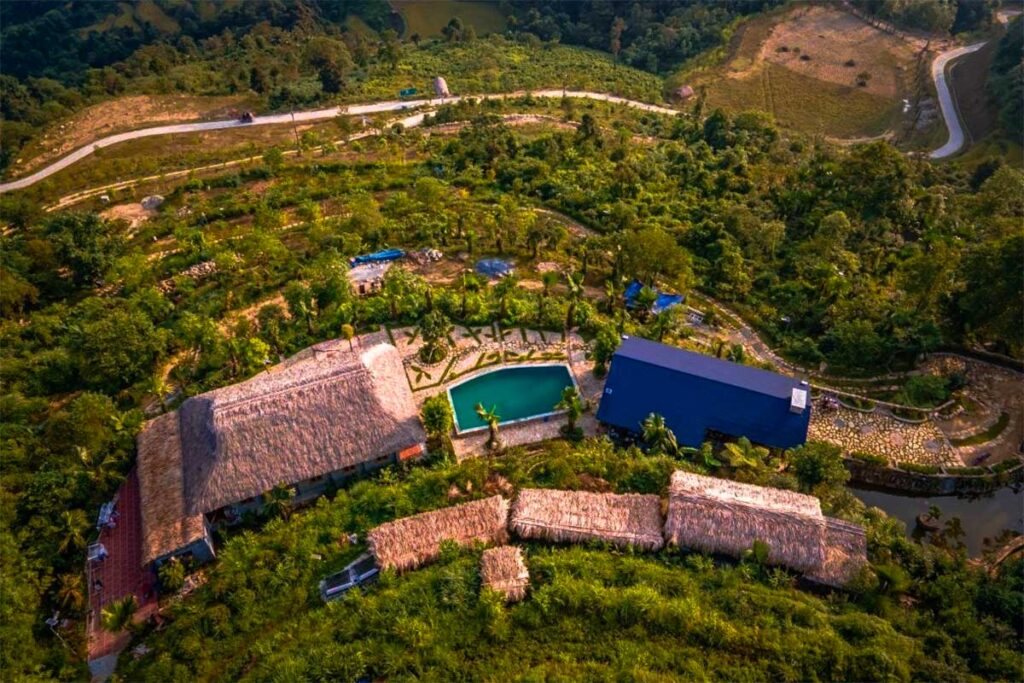
Lodges und Resorts sind entlang des Ha Giang Loops selten, aber die wenigen verfügbaren bieten eine Mischung der Vorteile von Hotels und Homestays. Diese Unterkünfte tendieren dazu, lokale Traditionen zu integrieren, eine gemütliche Atmosphäre zu bieten und zusätzliche Annehmlichkeiten wie hochwertige Betten, Klimaanlage und mehr Privatsphäre zu bieten. Obwohl sie teurer sind, stellen sie einen Mittelweg dar für diejenigen, die Komfort suchen, ohne auf das kulturelle Erlebnis zu verzichten.
Beste Reisezeit für den Ha Giang Loop
Der Ha Giang Loop bietet das ganze Jahr über unterschiedliche Erlebnisse, wobei jede Jahreszeit ihren eigenen Reiz für die Reise bringt. Die optimalen Monate für die Erkundung des Loops sind von September bis November und von Februar bis April, gekennzeichnet durch moderate Temperaturen, geringe Niederschläge und eine geringere Wahrscheinlichkeit von Nebel, was für klarere Aussichten und komfortableres Reisen sorgt.
Frühling (März – Mai)
Der Frühling ist eine wunderbare Zeit für den Ha Giang Loop, da das Wetter wärmer wird und die Landschaft mit blühenden Blumen, einschließlich Pfirsich- und Pflaumenbäumen, zum Leben erwacht. Der klare Himmel und das Fehlen der Regenzeit bieten ideale Bedingungen für die Erkundung und zeigen lebendige Naturfarben und angenehme Fahrbedingungen.
Sommer (Juni – August)
Die Sommermonate bringen höhere Temperaturen und mehr Niederschläge, was die Täler zwar atemberaubend grün und die Wasserfälle ausgeprägter macht, aber auch zu rutschigen Straßen und weniger komfortablen Fahrbedingungen führen kann. Trotz dieser Herausforderungen können die üppigen Landschaften besonders schön sein und eine einzigartige Perspektive auf die natürliche Schönheit Ha Giang’s bieten.
Herbst (September – November)
Der Herbst ist eine der besten Zeiten für einen Besuch, beginnend mit der Reisernte im September, die die terrassierten Felder in goldene Farben taucht. Im November blühen die Buchweizenblumen und bedecken die Landschaft in Rosa- und Lilatönen. Die Niederschläge nehmen ab und die Temperaturen kühlen sich ab, was für angenehme Reisebedingungen und lebendige Landschaften sorgt.
Winter (Dezember – Februar)
Der Winter in Ha Giang bringt kälteres Wetter, besonders in höheren Lagen, und eine erhöhte Wahrscheinlichkeit für neblige Tage, die die beeindruckenden Bergblicke verdecken können. Dennoch bietet die Zeit um das Tet-Fest (Januar oder Februar) ein einzigartiges kulturelles Erlebnis, da du mit den lokalen ethnischen Gemeinschaften feiern kannst. Beachte jedoch, dass die Region während dieser Zeit durch lokale Touristen überlaufen sein kann, die das neue Jahr feiern.
Ha Giang Loop 3-5 Tage Route
Wenn du deine Route entlang des Ha Giang Loop planst, ist es wichtig, dein Reiseprogramm sorgfältig zu überdenken, um eine erfüllende und stressfreie Erfahrung zu gewährleisten. Hier sind einige wichtige Tipps, die dir bei der effektiven Planung helfen:
- Mindestdauer: Plane mindestens 3 Tage und 2 Nächte ein, um die Schleife zu vollenden. Kürzere Reisen sind möglich, führen jedoch oft zu einer gehetzten Erfahrung und dem Verpassen bedeutender Sehenswürdigkeiten. Idealerweise verlängere deine Reise auf 4 Tage und 3 Nächte für ein entspannteres Tempo.
- Flexibler Reiseplan: Die vorgeschlagenen Routen dienen als Rahmen, aber fühle dich frei, sie nach deinen Interessen und deinem Tempo anzupassen. Wenn du genügend Zeit zum Erkunden hast und nicht nur von Punkt A nach B fährst, wird die Erfahrung bereichert.
- Unterkunftsplanung: Achte auf die Verfügbarkeit von Unterkünften, besonders in abgelegenen Gegenden. Um nicht gestrandet zu sein, plane deine Stopps an Orten, von denen bekannt ist, dass sie ausreichende Übernachtungsmöglichkeiten bieten.
- Berücksichtige die Fahrzeiten: Entfernungen in Ha Giang können täuschen. 100 km mögen nicht viel erscheinen, aber das gebirgige Gelände bedeutet längere Fahrzeiten. Berücksichtige dies in deiner Planung, um übermäßig lange Reisetage zu vermeiden.
- Ende-der-Tages-Orte: Versuche, jede Tagesetappe in Gegenden mit vielen Unterkunftsmöglichkeiten zu beenden. Diese Flexibilität kann besonders während der Hauptreisezeiten oder an Wochenenden entscheidend sein.
Ha Giang Loop in 3 Tagen und 2 Nächten
Tag 1: Ha Giang nach Dong Van
- Erkunde den Quan Ba Pass, Twin Mountains, Tham Ma Pass, Chin Khoanh Pass, Sung La Valley, Hmong Kings Palace und Dong Van Old Quarter.
Tag 2: Dong Van nach Lung Cu nach Meo Vac
- Besuche das Ma Le Dorf, Lung Cu Flag Tower, Ma Pi Leng Pass und den Nho Que Fluss.
Tag 3: Meo Vac nach Lung Ho nach Ha Giang
- Entdecke den M-förmigen Aussichtspunkt, Mau Due und Lung Ho.
Ha Giang Loop in 4 Tagen und 3 Nächten
Tag 1: Ha Giang nach Dong Van
- Erkunde den Quan Ba Pass, Twin Mountains, Tham Ma Pass, Chin Khoanh Pass, Sung La Valley, Hmong Kings Palace und Dong Van Old Quarter.
Tag 2: Dong Van nach Lung Cu nach Meo Vac
- Besuche das Ma Le Dorf, Lung Cu Flag Tower, Ma Pi Leng Pass und den Nho Que Fluss.
Tag 3: Meo Vac nach Lung Ho nach Du Gia
- Inklusive des M-förmigen Aussichtspunkt, Mau Due, Lung Ho, Du Gia und den Du Gia Wasserfall.
Tag 4: Du Gia nach Ha Giang
Ha Giang Loop in 5 Tagen und 4 Nächten
Tag 1: Ha Giang nach Yen Minh
- Reise durch den Quan Ba Pass, Twin Mountains, Lung Khuy Cave, Lung Tam Village und Yen Minh Pine Forest.
Tag 2: Yen Minh nach Lung Cu nach Dong Van
- Überquere den Tham Ma Pass, Chin Khoanh Pass, Sung La Valley, Pho Bang Old Town, Hmong Kings Palace, Lung Cu Flag Tower, Lo Lo Chai Village, Ma Le Dorf und Dong Van Old Quarter.
Tag 3: Dong Van zu Fuß nach Meo Vac
- Genieße eine halbtägige Wanderung rund um Dong Van, Ma Pi Leng Pass und den Nho Que Fluss.
Tag 4: Meo Vac nach Lung Ho nach Du Gia
- Besuche den M-förmigen Aussichtspunkt, Mau Due, Lung Ho, Du Gia und den Du Gia Wasserfall.
Tag 5: Du Gia nach Ha Giang
Die besten Sehenswürdigkeiten entlang des Ha Giang Loop
Die besten Sehenswürdigkeiten des Ha Giang Loop sind vielleicht nicht die aufgelisteten, sondern die abgelegenen Dörfer, die winkenden Kinder entlang der Straße, die farbenfrohen ethnischen Menschen und die atemberaubenden Ausblicke an jeder Ecke. Um dir jedoch einige der beliebtesten Highlights zu zeigen, kannst du diese Liste verwenden. Sie sind nicht von besten zu schlechtesten aufgeführt, sondern wie du sie entlang der vorher erwähnten Routen antreffen würdest.
1. Bac Sum Pass
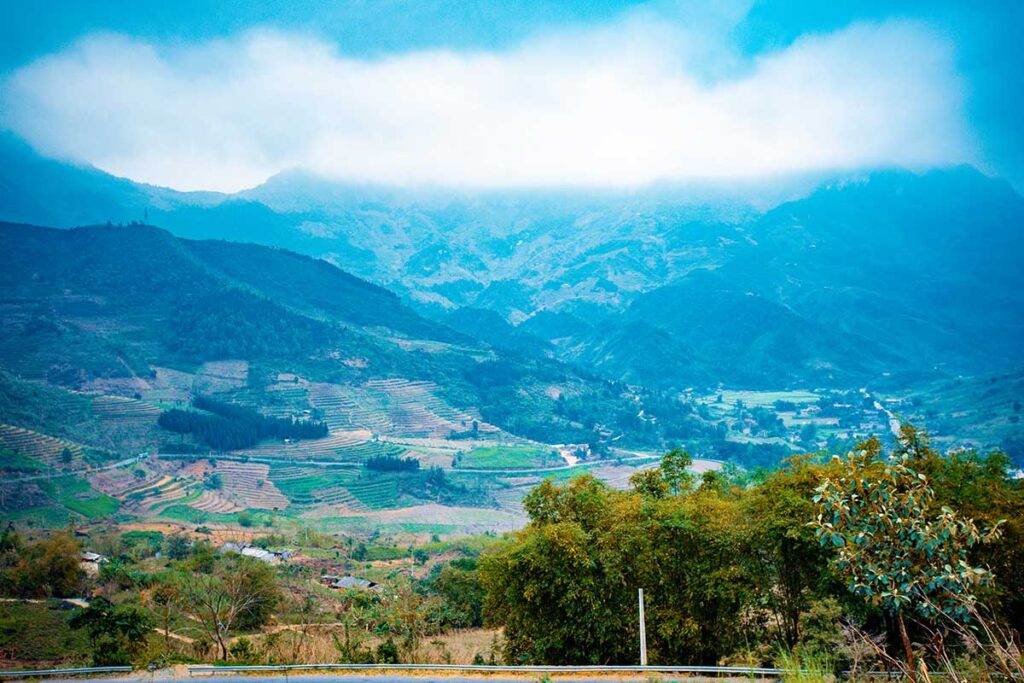
Die Reise auf dem Ha Giang Loop beginnt mit dem Bac Sum Pass, der den ersten Anstieg inmitten der rauen Schönheit der Region darstellt. Während er bezaubernde Aussichten bietet, sind diese nur ein Vorgeschmack auf die dramatischeren Landschaften, die weiter entlang der Route auf dich warten. Dieser erste Aufstieg führt dich sanft in die landschaftlichen Wunder von Ha Giang ein.
2. Quan Ba Pass
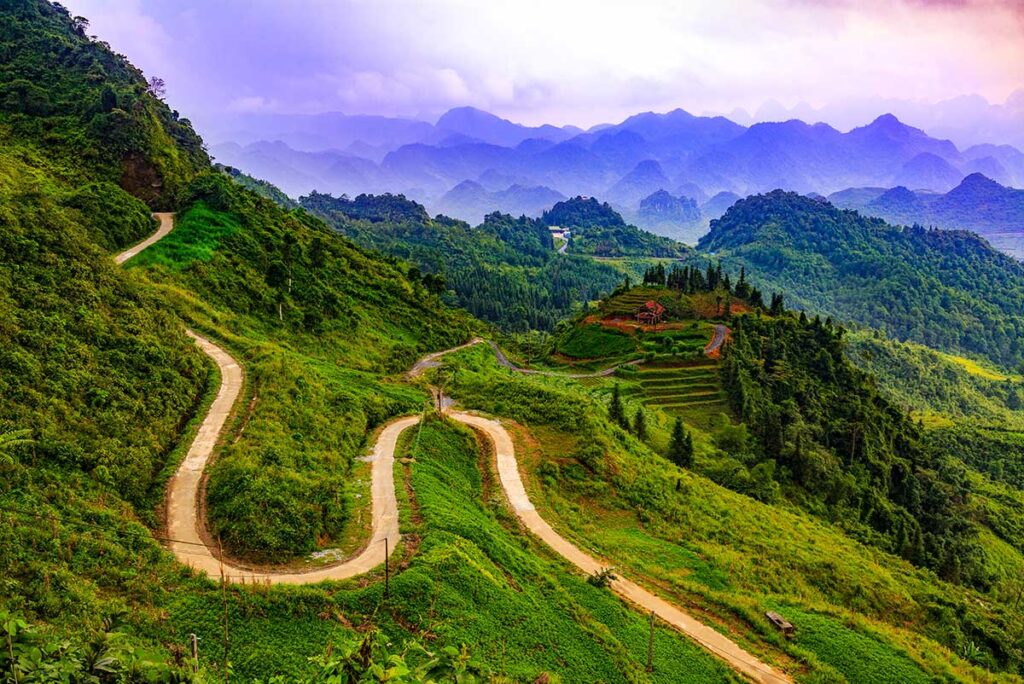
Der Aufstieg zum Quan Ba Pass, auch als Quan Ba Heaven Gate bekannt, markiert deinen Eintritt ins Herz der majestätischen Berge von Ha Giang. Oben befindet sich ein gemütliches Café, ein perfekter Ort, um zu pausieren und die Panoramaschönheit der umliegenden Gipfel zu genießen. Hier kannst du eine Tasse Kaffee oder heiße Schokolade trinken, während du die atemberaubenden Aussichten bewunderst.
3. Twin Mountains
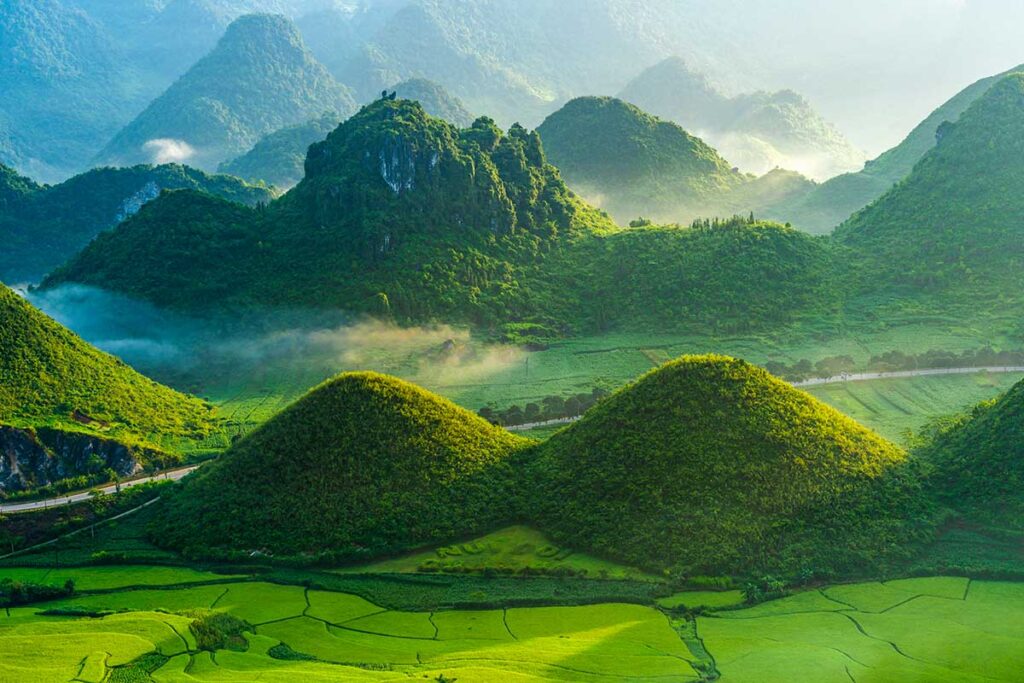
Die Fahrt hinunter vom Quan Ba Pass führt zu den Twin Mountains. Sichtbar von einem speziell gestalteten Aussichtspunkt, sind diese zwei perfekt geformten Hügel lokal als Fairy Breast Mountains bekannt.
4. Lung Khuy Höhle
Ein Abstecher von der Hauptstrecke zur Lung Khuy Höhle belohnt die Abenteuerlustigen. Obwohl sie nicht die größte Höhle in Vietnam ist, ist die Reise zur Lung Khuy ebenso faszinierend wie die Höhle selbst, mit einem Pfad, der durch malerische Landschaften führt. Im Inneren schafft das Spiel von Licht und Schatten auf den Formationen eine mystische Atmosphäre, die diesen Abstecher für diejenigen, die Zeit haben, jenseits der Hauptschleife zu erkunden, lohnenswert macht.
5. Lung Tam Dorf
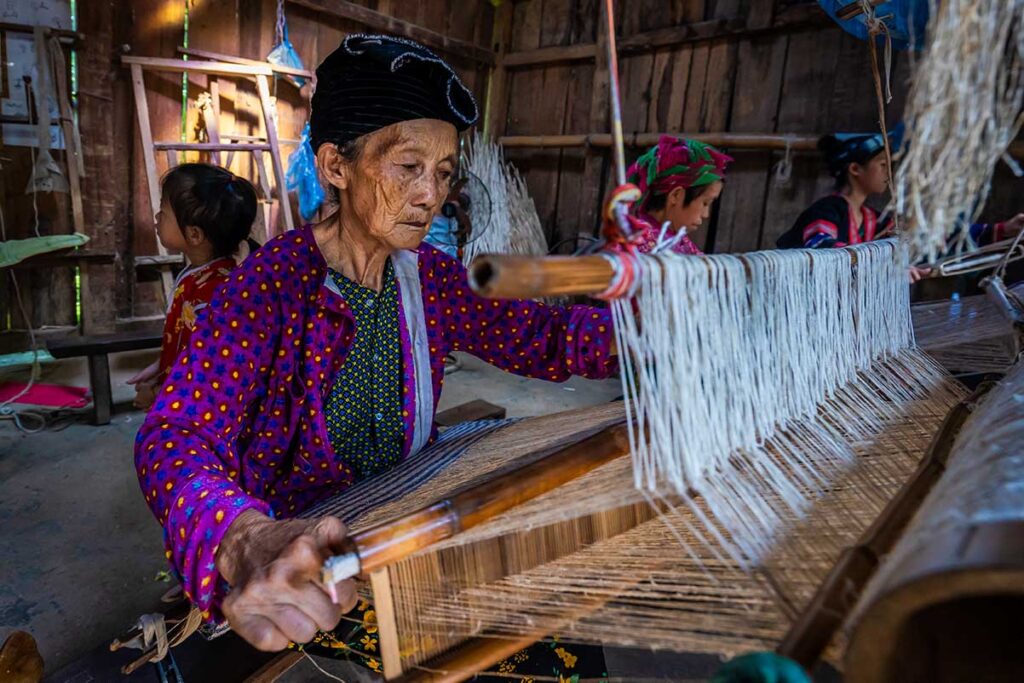
Das Lung Tam Dorf steht als lebendiges Zeugnis der reichen Textiltraditionen der Hmong ethnischen Gruppe. Besucher dieses Dorfes erhalten einen direkten Einblick in die kunstvolle Weberei, bei der die Einheimischen komplizierte Textilien herstellen, die die Geschichte ihrer Kultur und ihres täglichen Lebens erzählen.
6. Yen Minh Pinien Wald
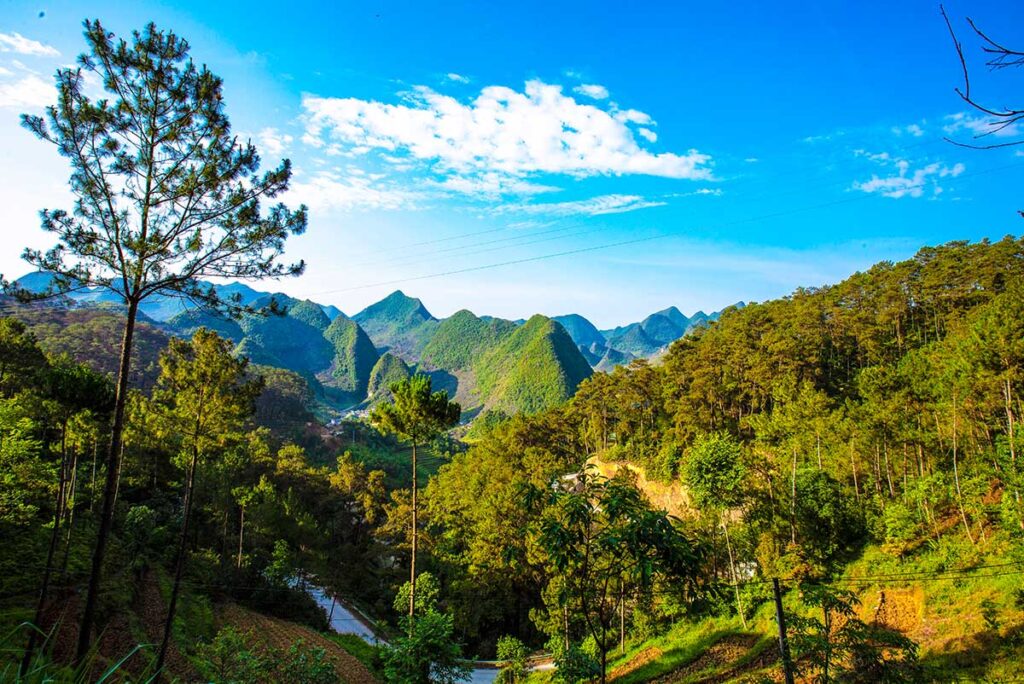
Die Reise nach Yen Minh Town bietet die Wahl zwischen zwei Routen, aber der Abstecher durch den Yen Minh Pinien Wald ist besonders lohnenswert. Dieser längere Weg führt Reisende in eine ruhige Oase aus hoch aufragenden Kiefern und bietet einen perfekten Rastplatz.
7. Tham Ma Pass
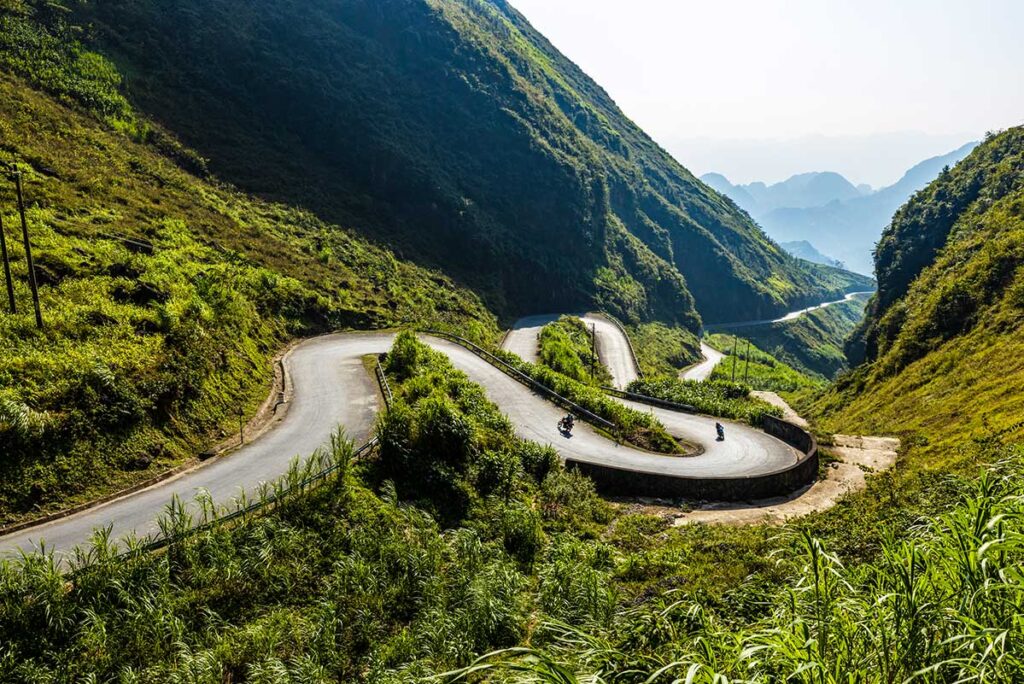
Der Tham Ma Pass wird nicht nur für seine atemberaubende Schönheit gefeiert, sondern auch als Symbol für das raue Gelände von Ha Giang, oft in Werbematerialien für die Region gezeigt. Der Pass zeichnet sich durch eine elegante S-förmige Straße aus, die anmutig durch die Berge klettert. An seinem Aussichtspunkt trifft man oft auf lokale Kinder ethnischer Gruppen, die Blumen tragen.
8. Chin Khoanh Pass

Dicht gefolgt vom Tham Ma Pass, fordert der Chin Khoanh Pass Reisende mit seinen neun scharfen Kurven heraus, die steil in die Berge aufsteigen. Lokal als 9 Ramp bekannt, bietet dieser Pass mehrere Stellen, um anzuhalten und die weiten Ausblicke auf das darunter liegende Tal zu genießen.
9. Sung La Tal
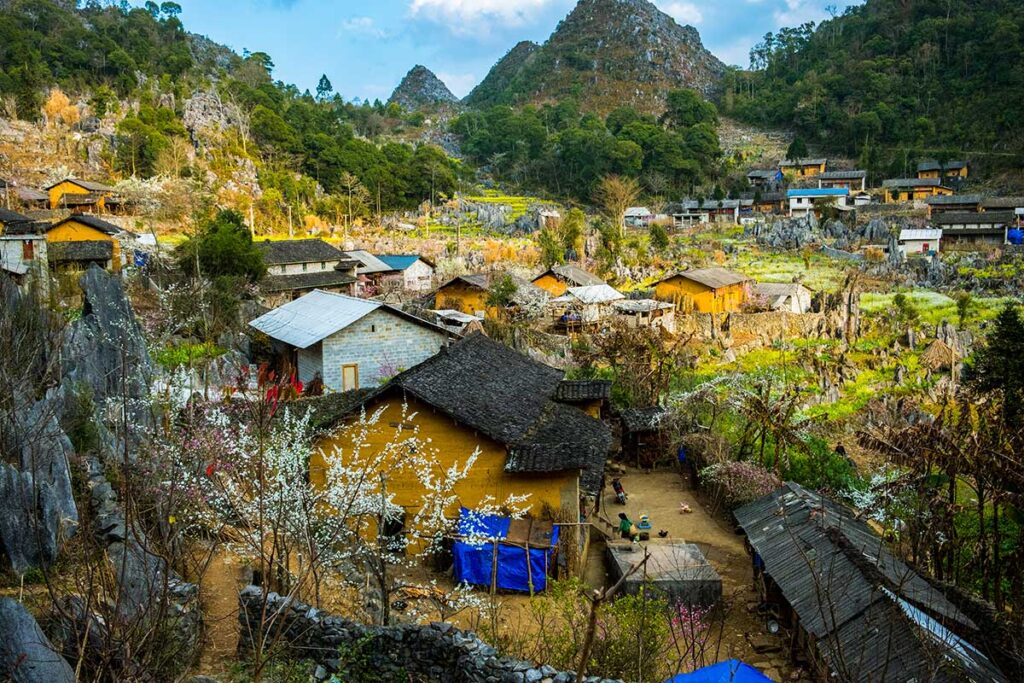
Nach der Fahrt über den Chin Khoanh Pass findest du dich im Sung La Tal wieder, einem Ort, der sowohl visuell atemberaubend als auch kulturell reich ist. Das Tal ist besonders schön, wenn die Buchweizenblumen blühen und die Landschaft in ein Meer aus Weiß und Rosa verwandeln. Es beherbergt mehrere Hmong-Dörfer, in denen Traditionen seit über hundert Jahren bewahrt werden. Unter diesen sticht Paos House hervor. Auch wenn du den vietnamesischen Film, der es berühmt gemacht hat, nicht gesehen hast, bietet das Haus selbst einen tiefen Einblick in die Hmong-Kultur und zeigt traditionelle Architektur und Lebensweisen.
10. Pho Bang „antikes“ Dorf
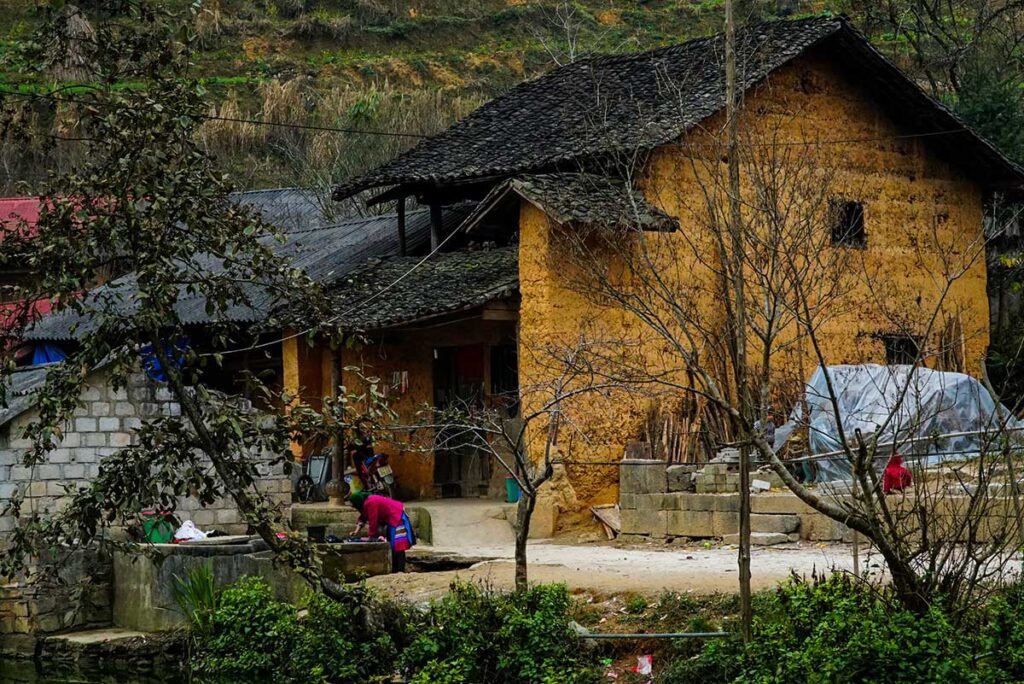
Ein Abstecher zur Pho Bang „antikes“ Dorf bietet einen Einblick in ein fast vergessenes Dorf. Dieses abgelegene Ziel fühlt sich an, als wäre man am Ende der Welt, wo das traditionelle Leben gemächlich vor dem Hintergrund alter, traditioneller Architektur voranschreitet.
11. Hmong Kings Palast
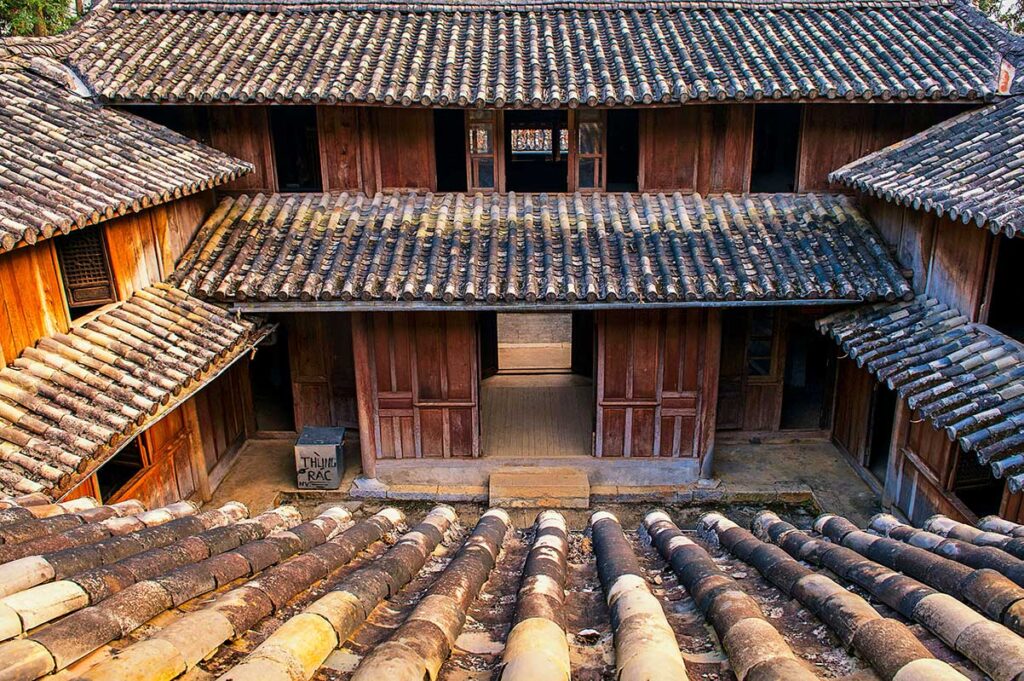
Kurz vor Dong Van erreichst du den Hmong Kings Palast, einst die Residenz von Vuong Chinh Duc, einem Anführer, der von den Hmong-Leuten im frühen 20. Jahrhundert anerkannt wurde. Erbaut im Jahr 1902, wurden die robusten Steinmauern des Palastes entworfen, um vor Invasionen zu schützen.
12. Dong Van Old Quarter

Der Dong Van Old Quarter dient als historisches Zentrum von Dong Van und bewahrt seinen Charme mit engen Straßen, gesäumt von alten Häusern aus der französischen Kolonialzeit. Diese Gebäude, die nun in gemütliche Restaurants und Geschäfte umgewandelt wurden, bieten eine gemütliche Atmosphäre für Reisende, die die reiche Geschichte der Stadt erkunden möchten.
13. Dong Van Markt
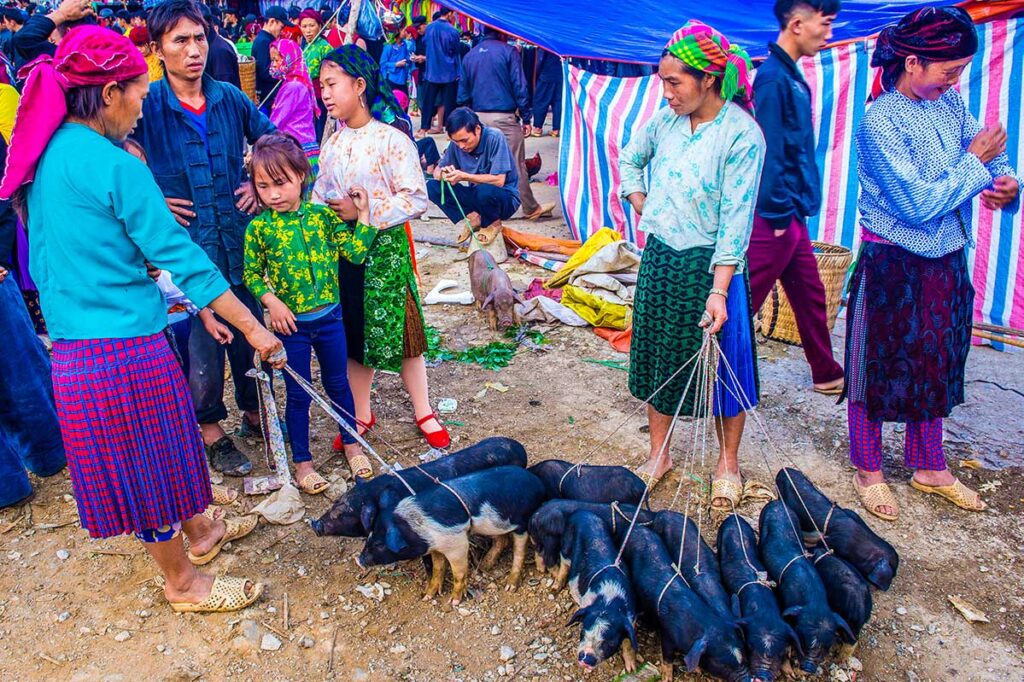
Der Dong Van Markt ist ein lebendiger Treffpunkt für verschiedene ethnische Gruppen, darunter die Hmong, Tay, Nung und Hoa. Jeden Sonntag kommen sie in einer farbenfrohen Darstellung von Kultur zusammen und verkaufen alles von traditionellen Textilien und landwirtschaftlichen Werkzeugen bis hin zu modernen Geräten und Vieh, was den Markt zu einem Mittelpunkt sowohl für soziale als auch wirtschaftliche Aktivitäten macht.
14. Ma Le Dorf
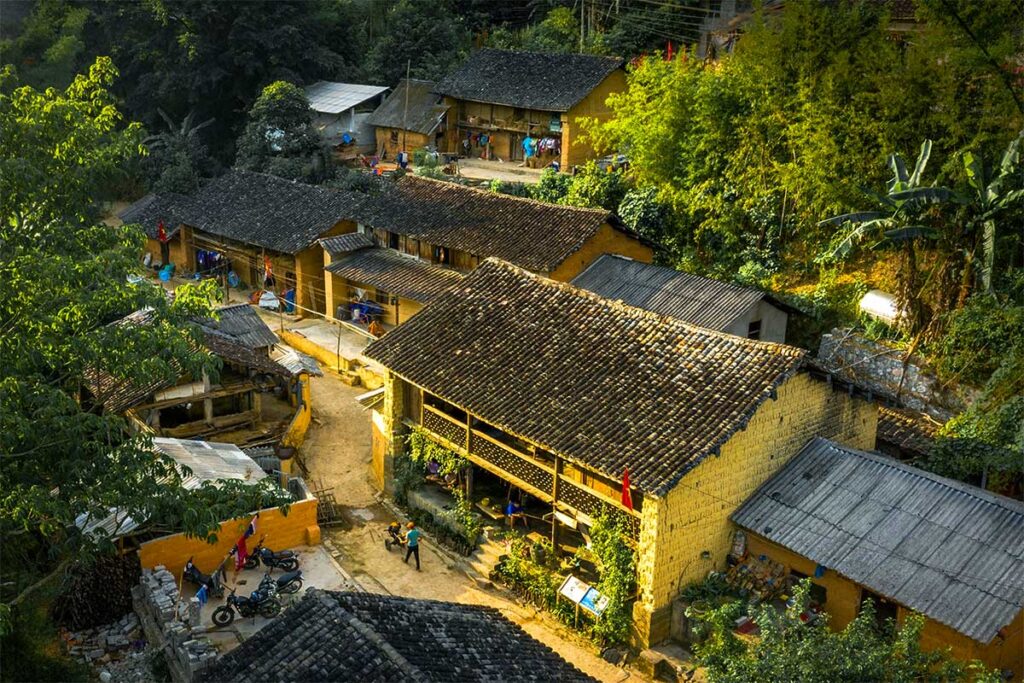
Ein Besuch im Ma Le Dorf ist wie ein Schritt in ein lebendiges Museum, in dem die traditionellen Lebensweisen ethnischer Minderheiten bewahrt werden. Die Architektur des Dorfes, geprägt von Holzkonstruktionen und gelbem Lehm, bietet ein lebendiges Bild des architektonischen Erbes der Region und ermöglicht dir ein echtes Erlebnis des ländlichen Lebens in Ha Giang.
15. Lo Lo Chai Dorf
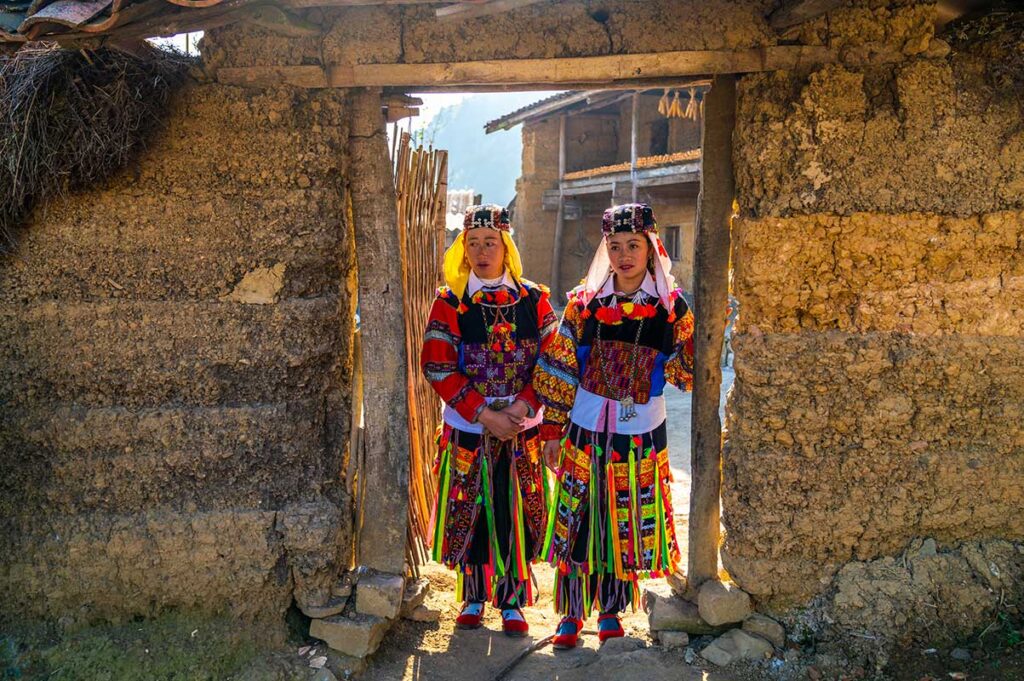
Lo Lo Chai Village, am Fuße von Lung Cu, ist eine authentische Darstellung der Kultur der Lo Lo-Minderheit. Das Dorf ist bekannt für seine charakteristischen gelben Lehmhäuser und die farbenfrohe, kunstvolle Kleidung der Lo Lo-Frauen, die zu den auffälligsten in Vietnam gehört. Besucher können tief in die Traditionen des Dorfes eintauchen und sogar eine Nacht in einem Homestay verbringen, was dein Verständnis des lokalen Lebens weiter bereichert.
16. Lung Cu Flaggenturm
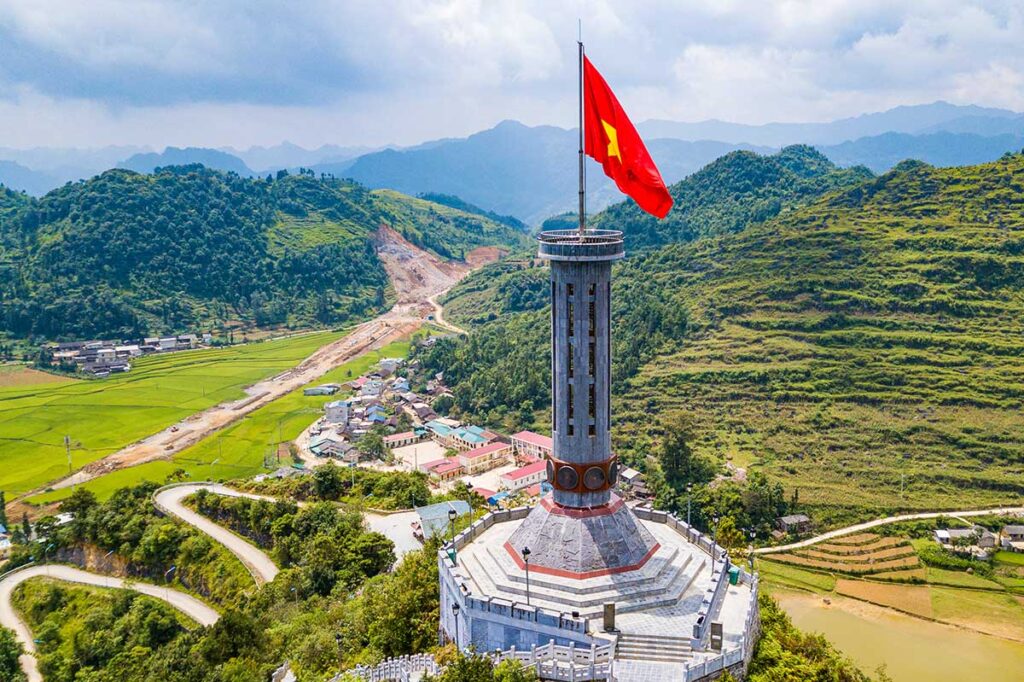
Der Lung Cu Flaggenturm, der sich auf einem Berggipfel befindet, markiert den nördlichsten Punkt Vietnams und steht als Symbol des nationalen Stolzes. Vom Aussichtspunkt hast du einen Blick über sowohl Vietnam als auch China.
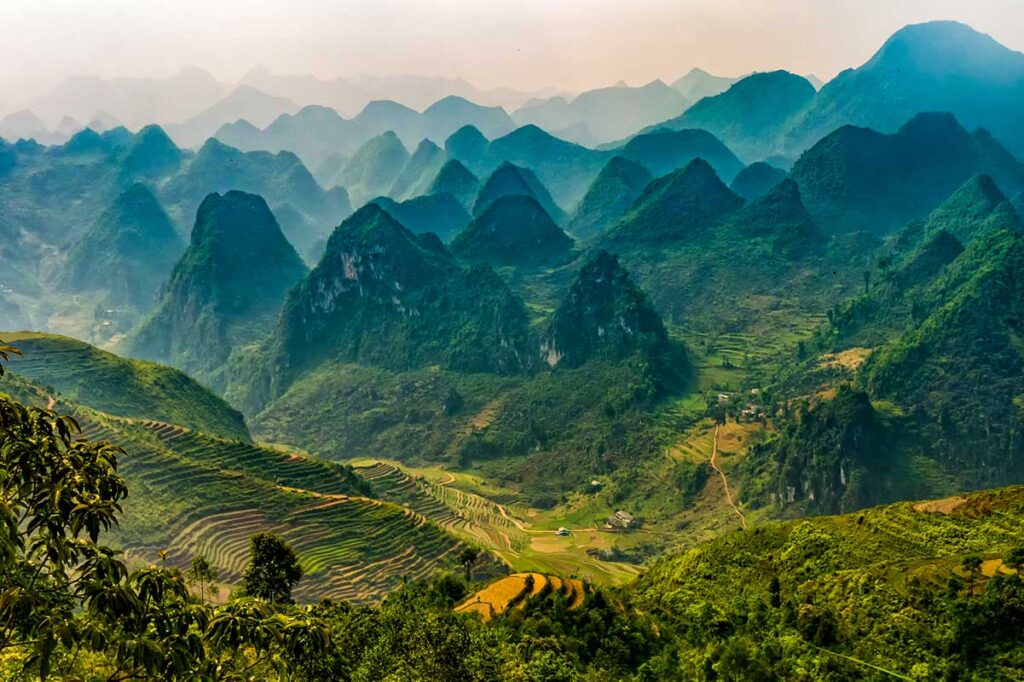
Die Fahrt von Dong Van nach Lung Cu könnte sogar ein größeres Highlight sein als der Flag Tower selbst. Es ist eine der landschaftlich reizvollsten Strecken mit atemberaubenden Aussichten an jeder Ecke.
17. Ma Pi Leng Pass
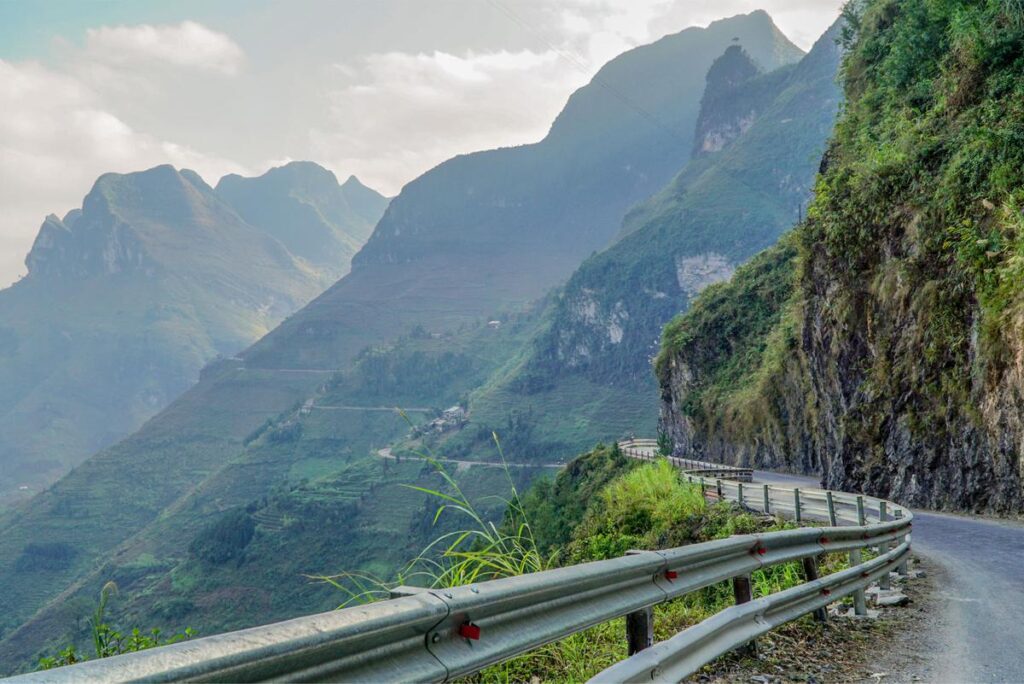
Der Ma Pi Leng Pass, bekannt als der König der vietnamesischen Gebirgspässe, ist für viele Reisende das größte Highlight des Ha Giang Loops. Der Pass zieht sich zwischen Dong Van und Meo Vac entlang und bietet atemberaubende Ausblicke auf steile Klippen, die zum Fluss hinunterführen.
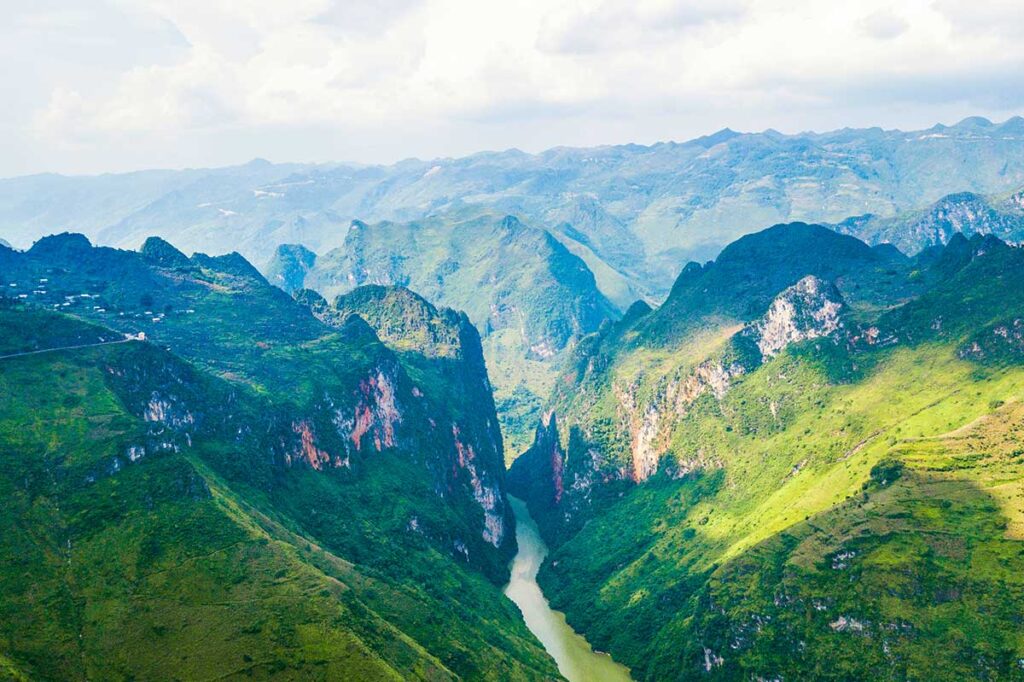
Die Fahrt über den Ma Pi Leng ist ein unvergessliches Erlebnis mit atemberaubenden Ausblicken. Neben dem Pass bietet der Ma Pi Leng Skywalk eine einzigartige Perspektive und ermöglicht es dir, noch höher hinauf zu steigen.
18. Nho Que Fluss
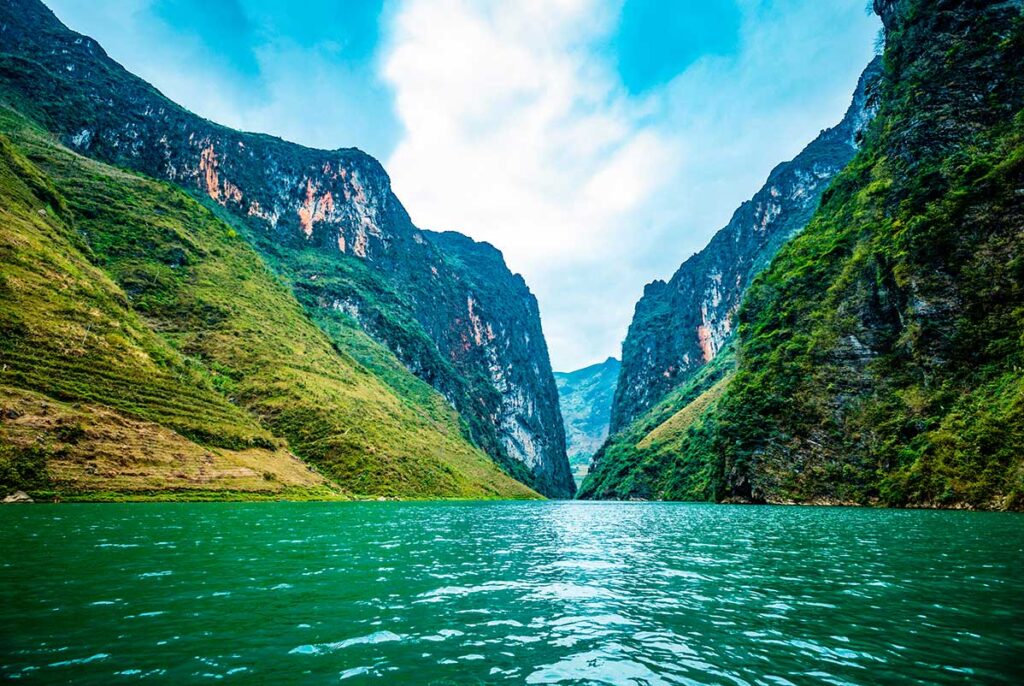
Von den Höhen des Ma Pi Leng Pass aus kann man den Nho Que Fluss sehen, der sich durch den tiefen Canyon darunter schlängelt. Sein türkisfarbenes Wasser zieht einen ruhigen Pfad durch die raue Landschaft. Abenteuerlustige Reisende können zum Fluss hinabsteigen und eine Bootsfahrt unternehmen, die einen näheren Blick auf die majestätischen Canyonwände bietet und eine andere Perspektive auf die Größe des Passes ermöglicht.
19. Meo Vac Markt
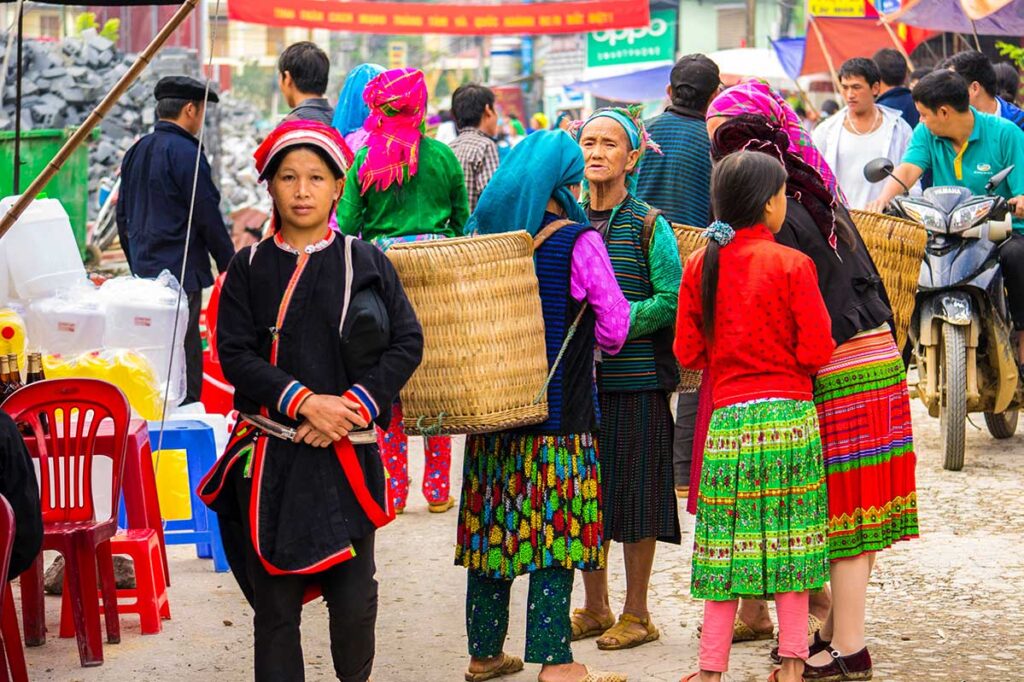
Der Meo Vac Markt ist der größte Markt ethnischer Minderheiten in Ha Giang. Er pulsiert vor Leben, wenn sich die lokalen Gemeinschaften versammeln, um alles von Vieh wie Büffeln und Kühen bis hin zu lokalen Produkten zu handeln. Der Markt ist ein Kaleidoskop von Farben und Klängen, wo soziale Interaktionen und kultureller Austausch ein lebendiges Bild des lokalen Lebens und der Traditionen zeichnen.
20. Der M-Kurven Aussichtspunkt
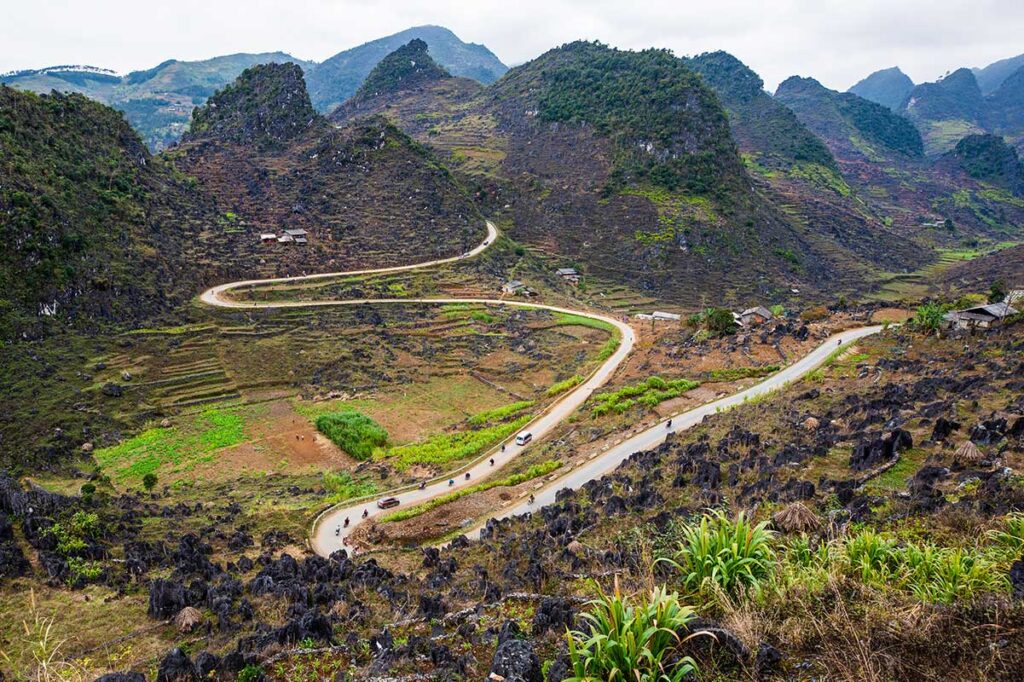
Der M-Kurven Aussichtspunkt ist bekannt für seine markante Straße, die in Form eines „M“ den Berg hinauf verläuft.
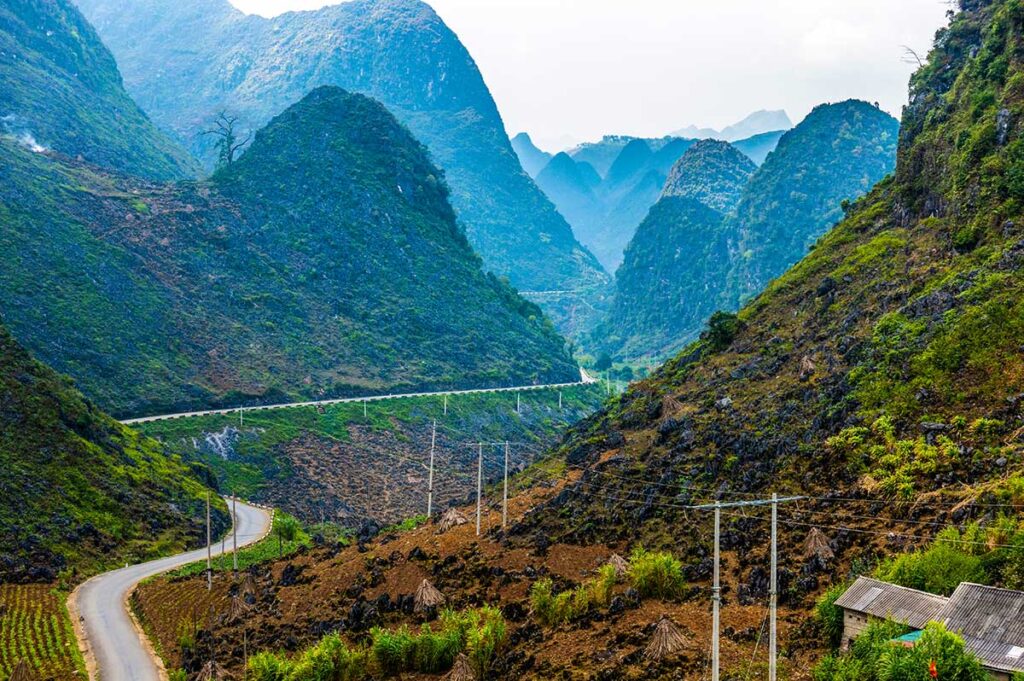
Der M-Kurven Aussichtspunkt ist nur ein Highlight auf dem Abschnitt zwischen Meo Vac und Mau Due. Während dieser spezielle Ort bemerkenswerte Ausblicke bietet, ist die gesamte Route mit landschaftlich reizvollen Punkten gespickt, die zu häufigen Stopps einladen, um die beeindruckende Umgebung vollständig zu genießen.
21. Mau Due
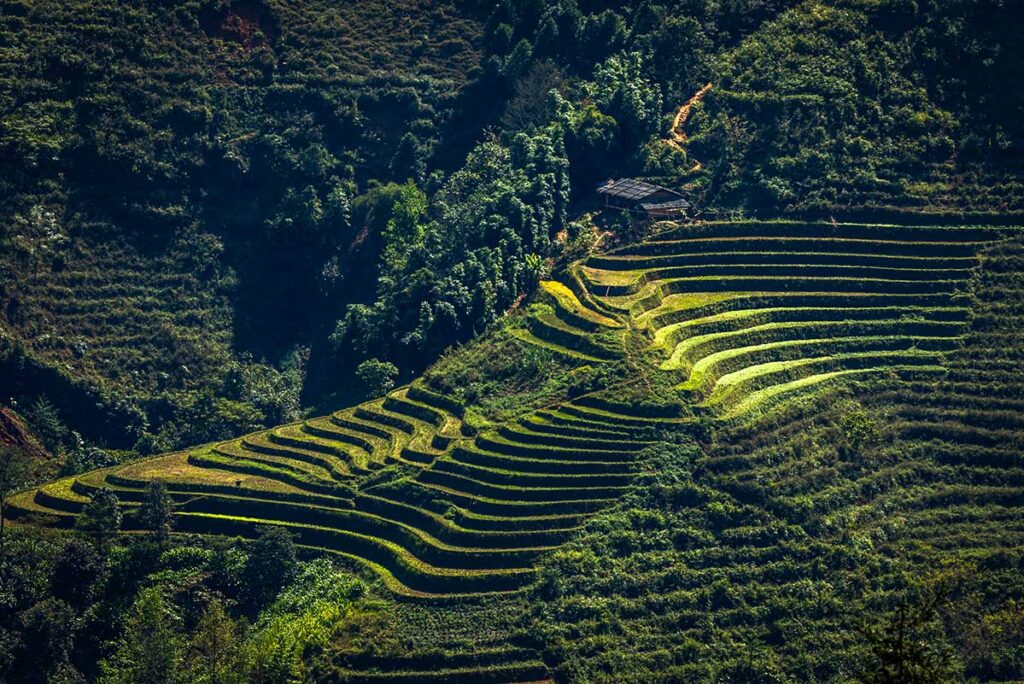
Nach dem rauen, felsigen Gelände von Dong Van und Meo Vac bietet Mau Due eine erfrischende Veränderung der Szenerie mit seinen üppigen, grünen Landschaften. Dieses Gebiet sticht als einer der wenigen Orte entlang des Ha Giang Loops hervor, wo du Terrassenreisfelder finden kannst.
Ein Besuch in Mau Due Ende August oder im September ermöglicht es dir, die Reisfelder auf ihrem Höhepunkt zu erleben, wenn sie in den goldenen Tönen der Erntezeit leuchten.
22. Lung Ho
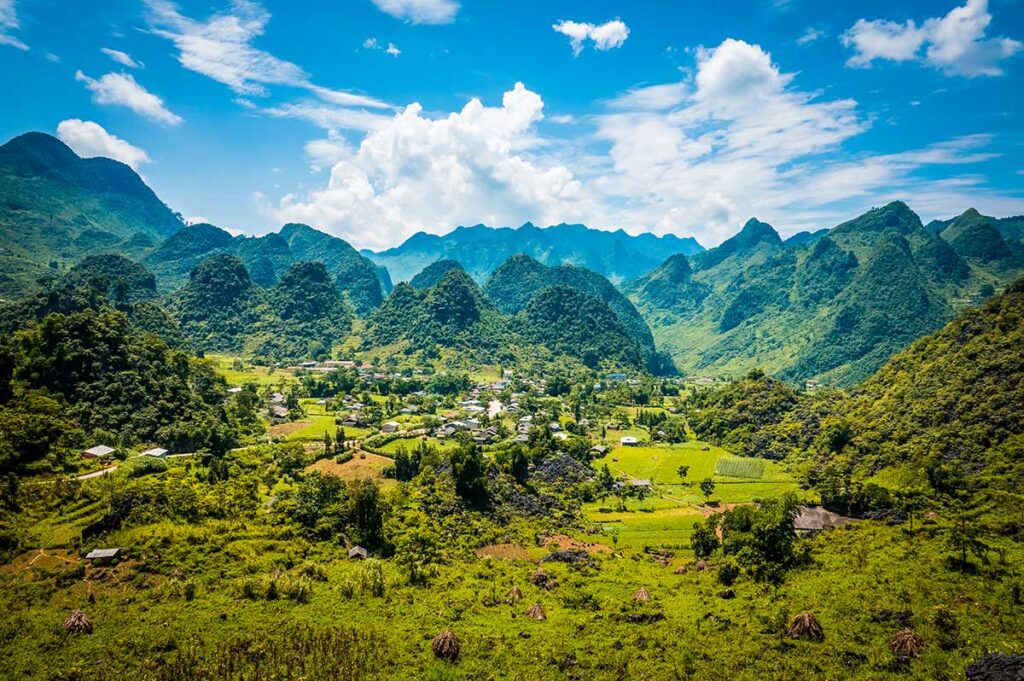
Der Aussichtspunkt in Lung Ho bietet einen seltenen Anblick von runden, kegelförmigen Bergen, die ein einzigartiges und faszinierendes Panorama schaffen.
23. Du Gia & Wasserfall
Du Gia, ein bevorzugter Halt für diejenigen auf der 4-Tage, 3-Nächte-Loop-Tour, kontrastiert die raue Szenerie des restlichen Loops mit seinen üppig grünen Tälern und reichlich Reisfeldern. Heimat der ethnischen Tay, die in traditionellen Stelzenhäusern leben, ist das Dorf mit charmanten Homestays übersät, die einen Blick auf die Reisfelder bieten und es zu einem idealen Ort für Entspannung und Übernachtungen machen.
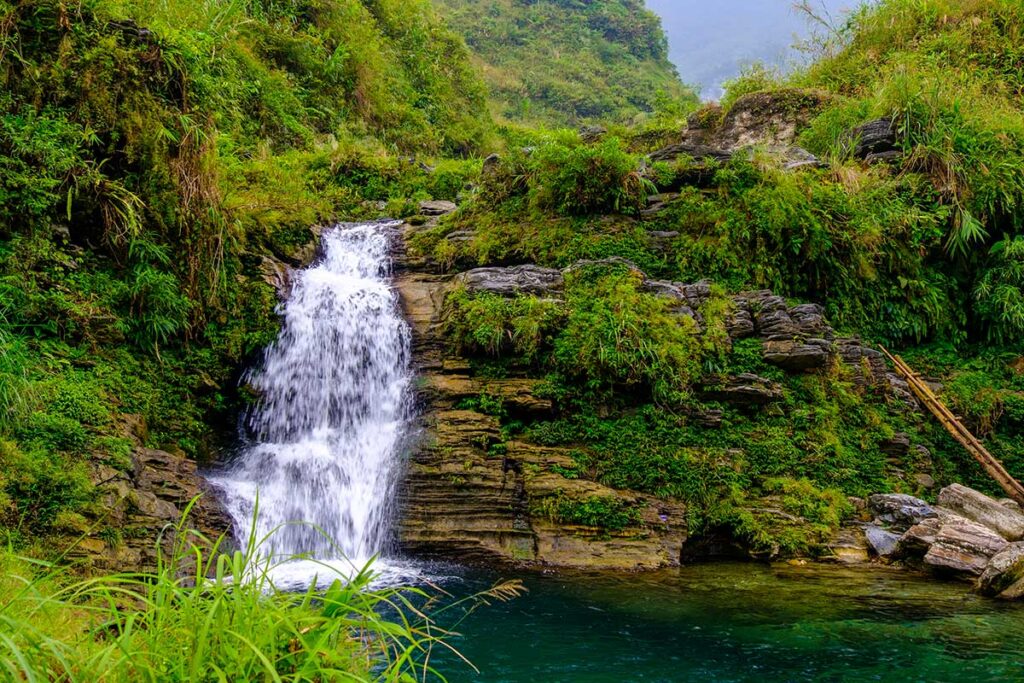
In der Nähe bietet der Du Gia Wasserfall einen erfrischenden Rückzugsort, wo Besucher an heißen Tagen inmitten einer friedlichen Naturschönheit abkühlen können. Trotz seiner Ruhe kann der Wasserfall Menschenmengen anziehen, was eine lebhafte Atmosphäre zu diesem ansonsten ruhigen Rückzugsort hinzufügt.
Tipps für den Ha Giang Loop
Wie gefährlich ist der Ha Giang Loop?
Der Ha Giang Loop ist bei vorsichtigem Verhalten nicht von Natur aus gefährlich. Die meisten Unfälle betreffen unerfahrene Backpacker auf Motorrädern. Erfahrene Fahrer sollten sicher fahren, während Anfänger Easy Rider-Touren oder Autoreisen für eine sicherere Reise in Betracht ziehen sollten.
Eine vietnamesische SIM-Karte besorgen
Die Abgeschiedenheit von Ha Giang bedeutet, dass nicht alle Orte Wi-Fi bieten. Eine lokale SIM-Karte gewährleistet Konnektivität, was bei der Navigation und Kommunikation hilft.
Nützliche Apps & Offline-Downloads
Angesichts des unzuverlässigen Service in abgelegenen Gebieten lade Offline-Karten und ein vietnamesisches Wörterbuch auf Google Translate im Voraus herunter, um eine nahtlose Navigation und Kommunikation zu gewährleisten.
Was tun mit deinem Gepäck?
Autos bieten ausreichend Platz für Gepäck. Motorräder und Easy Riders nutzen Racks für Rucksäcke und kleine Koffer. Für größere Gegenstände oder Bequemlichkeit lagere dein Gepäck in Ha Giang City oder in deinem Hotel in Hanoi, da die Reise eine Schleife bildet.
Schichten tragen
Schichtkleidung ist der Schlüssel für Motorradtouren, da sie sich an schwankende Temperaturen und Wetterbedingungen anpassen lässt, ohne zu sperrig zu sein.
Essen und Restaurants entlang der Loop
Außerhalb größerer Städte sind die Essensmöglichkeiten lokal. Reisen mit einem Guide stellen sicher, dass die Mahlzeiten geregelt sind. Soloreisende sollten darauf achten, wo Guides essen, um gute Lokale zu finden.
Sicherheit beim Fahren
Behalte den Fokus, mäßige deine Geschwindigkeit, insbesondere bei nassen Bedingungen, und sorge dafür, dass dein Motorrad in gutem Zustand ist, wobei du besonders auf die Bremsen achten solltest. Erwarten Überraschungen wie Tiere oder Schlaglöcher und vermeide das Fahren bei Nacht.
Wanderaktivitäten
Neben dem Fahren bietet Ha Giang außergewöhnliche Wandermöglichkeiten. Diese Wege führen durch Dörfer ethnischer Minderheiten und atemberaubende Landschaften und bieten ein intimeres Erlebnis mit der natürlichen Schönheit und Kultur der Region.
Kombination von Ha Giang mit Cao Bang & Ban Gioc Waterfall
Von Meo Vac aus können Reisende nach Cao Bang fahren, um den Ban Gioc Waterfall zu besuchen und die Schleife zu umgehen. Diese Erweiterung bietet einen Einblick in die ruhigen und malerischen ländlichen Landschaften und weniger begangenen Pfade Nordvietnams.
